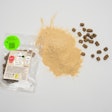
A meta-analysis of functional foods research summarized 17 peer-reviewed studies on dog and cat food ingredients, including rice bran, mushrooms, turmeric and plant components like inulin and fructooligosaccharides (FOS). The journal Research in Veterinary Science published the meta-analysis of research on pet food ingredients.
Although the US Food and Drug Administration doesn’t have a legal definition for functional foods, the Mayo Clinic defines them as “foods that have a potentially positive effect on health beyond basic nutrition.” Functional ingredients in pet foods often are marketed to address specific health concerns such as digestion, joint and cartilage function, immune system strength or dental health.
Functional foods in dog nutrition and health
In the functional foods studies, scientists found that some ingredients seem to benefit pet health. For example, several studies provided evidence that FOS, which are present in blue agave, chicory root, bananas and other plants, may reduce Clostridium perfringens bacterial concentrations in dogs’ feces or improve gut health in other ways.
Similarly, another study examined what happens to dogs after six months of eating food enriched with FOS, amino acids and a mixture of functional ingredients: hen-of-the-woods mushrooms (Grifola frondosa), turmeric (Curcuma longa), papaya (Carica papaya), pomegranate (Punica granatum), aloe (Aloe vera), knotweed (Polygonum L.), red algae (Haematococcus pluvialis), tomato (Solanum licopersicum) and grapes (Vitis vinifera). After the six months, the dogs eating the functional food diet had lower levels of potentially harmful reactive oxygen metabolites, commonly known as free radicals, than dogs that ate a conventional diet.
“This evidence supports the idea that an adequate diet may be crucial to achieve a good oxidative balance in dogs,” wrote the authors of the meta-analysis.
Dog fertility may be improved by some functional foods too. Scientists fed 14 dogs a special food made with hydrolyzed fish and potato proteins, amino acids, Mojave yucca (Yucca schidigera), Peruvian maca (Lepidium meyenii), goatshead weed (Tribulus terrestris) and other ingredients. A constant improvement in testosterone metabolic activity was observed within 45 days after beginning of the enrich diet compared to dogs fed a control diet. Likewise, semen significantly increased in motility and vitality in dogs aged between 2 and 7.
“These results suggest that a diet enriched with antioxidants can be used to achieve a better reproductive performance,” wrote the authors of the meta-analysis.
Evidence from other studies found that functional ingredients in dog foods may help treat cognitive deficits and behavioral disturbances. Other studies noted improvements in the odor of dog’s breath after being fed certain functional food-enriched diets. Stabilized rice bran, as a functional ingredient, also improved palatability and digestibility in another study.
Functional foods in cat nutrition and health
Fewer studies have examined the health effects of functional foods on cats. In one of these studies, cat foods enriched with soy products were fed to 55 cats with chronic diarrhea. All those cats’ conditions improved within one week of starting the soy diet. One-third of the cats developed normal feces by the end of the three-week study.
Apple pomace, the leftovers from making cider, may be a functional food for cat weight-loss diets. Nine adult, neutered, obese cats were fed a meat-based diet with different levels of apple pomace added. At 10 and 20 percent, the apple pomace didn’t decrease palatability, while it did reduce the energy density of the foods.
“Therefore, inclusion of palatable fibrous components at a restricted inclusion rate in the diet of obese cats represents a good way to reduce food energy content and maintain a physiological level of food intake,” wrote the authors of the meta-analysis.
Limitations of functional food research in cats and dogs
Far more studies have examined functional foods in humans, noted the authors. Since humans and their pets have different biological systems, these human studies may not be applicable to dogs or cats.
At the same time, consumers increasingly demand functional foods and may transfer trends from human nutrition to pet nutrition. This may lead to confusion, if consumers aren’t well informed.
“The ultimate success of functional pet foods will depend on delivering bioactive components in a predictable, safe and functional manner to effectively reduce the risk of disease and support the domestic animal's body,” wrote the authors of the meta-analysis.
The authors called on other food scientists, as well as the pet food industry, to educate the public using peer-reviewed research that establishes safe and effective uses of those functional ingredients.



















